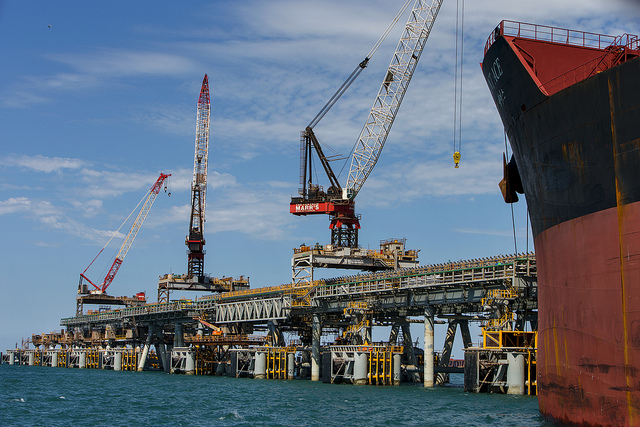China’s One Billion Tonne Question

The billion tonne question is raging. China’s tumult has been well publicised in recent weeks, but for coking coal and seaborne iron ore, the key question remains: will Chinese steel output ever trip through 1 billion tonnes per annum.
If it does, continued output expansion by mining companies is arguably justified. But if it doesn’t, the biggest investment decisions made by Rio Tinto and BHP Billiton over the last 10 years will increasingly look like high tide economics.
Roughly one and a half tonnes of iron ore are needed for every tonne of steel produced and with China accounting for 50 to 60 per cent of the global market in both, its steel production has become an intense point of focus for analysts and mining companies alike.
Heading Lower
Investment banks estimate that China’s steel production is currently running at a yearly rate of around 820 million tonnes, heading lower at roughly 1 to 2 per cent per annum. The country continues to open new steel mills, but is thought to be closing down older mills at a faster rate, in line with its latest anti-pollution measures, which have severely clamped down on the burning of low-quality coal.
As recently as May, mining giant BHP Billiton forecast peak Chinese steel capacity of 1.1 billion tonnes per annum. But the company has now relinquished 1 billion tonnes as a plausible target, revising its peak forecast sharply lower by as much as 15 per cent, to between 935 and 985 million tonnes by the mid-2020s.
Rival Rio Tinto however, which describes itself as “the best mining house in the street”, has doggedly stuck to its own forecasts of 1 billion tonnes per annum by 2030. Its head of iron ore (a post that previously gave rise to group CEO Sam Walsh) Andrew Harding has said the world is entering a “new normal” of lower headline growth, but underpinned by global GDP expansion of 3 per cent each year, he says iron ore demand will continue to rise, if not accelerate.
Already Happened
Analysts vehemently disagree. Investec for example “strongly believes that peak steel output from China has already happened, at least for the foreseeable future.” The bank expects to see “a gradual climb-down” by major mining companies, from what it describes as “wildly optimistic forecasts” made during the over-excitement of the so-called supercycle.
Rio’s bullish outlook has, however, served to justify its marketshare-grabbing output splurge in iron ore. Prices have tumbled from $190 per tonne in early 2011 to around $60 today, yet Rio continues to open new mines: it is targeting shipments of 360 million tonnes each year, up from 340 million this year, a figure that has nearly doubled since 2009.
Its Silvergrass mine in Australia’s prolific Pilbara region has been deferred three times and publicly, an investment decision on the new mine will not be made by Rio’s board until next year. But pre-empting the decision and betraying its internal strategy, the group has already awarded mining contracts over the deposit.
Faulty Figures
Trading giant Glencore recently conceded that “at the moment, none of us can read China.” Rio Tinto conversely has boasted that it spends “millions” on economic research, with its chief economist Vivek Tulpule lifting the bonnet in August on its “granular bottom-up approach” to statistics, analysing data in more than 800 spots across China.
Despite its recent U-turn, BHP Billiton has likewise trumpeted its macro skills. “We don’t find China impossible to read,” according to chief executive Andrew Mackenzie. “We’ve been at this game for decades.”
Bold Claims
For investors and industry observers, it is a bizarre claim for BHP to make, no less absurd than the remarkably specific forecasts that mining companies seemingly feel at liberty to make. Through M&A, both Rio and BHP have repeatedly demonstrated that their insight into macro trends and the direction of the cycle is zero (at best).
Rio swallowed aluminium maker Alcan for $44 billion in cash at the top of the market in 2007, but BHP’s blushes would have been three times redder, if its $140 billion merger with Rio in 2008 had not been slowed down by regulators and finally blocked by the financial crisis.
As Glencore says, reading China may be difficult. But for now, taking the opposite view to Rio and BHP looks like the safest bet.
Comments (0)